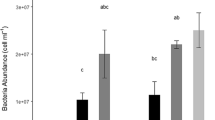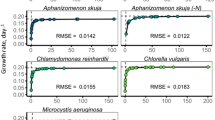Abstract
Specific affinity theory is compared with traditional ways of understanding the nutrient concentration dependency of microbial growth. It is demonstrated that the Michaelis constant increases with the ratio of metabolic enzyme to membrane permease content of bacteria so that small values can reflect specialization for nutrient collection. When compared to the specific affinity, Kt gives a measure of oligotrophic capacity. Specific affinity, on the other hand, reflects nutrient collection ability directly, and increases with the number of permeases. It can be estimated, along with the other kinetic constant, Vmax, by use of isotopes in natural samples. Because of systematic errors in estimating Vmax, specific affinity is the preferred measure of substrate accumulation ability. The advantage of simultaneous collection of multiple substrates in dilute solution is demonstrated. The structural basis of this advantage is computed from collision frequency and recollision probability, computations that further show that multisubstrate usage is essential for bacterial growth under low-nutrient conditions. Computed growth rates from specific affinities require that several substrates be used simultaneously for growth at measured concentrations. Formulations anticipate that the surface of oligobacteria should be occupied by a diversity of transporter types, that each type of transporter should occupy only a small portion of the cell surface, and the number of cytoplasmic enzymes can be small, allowing small cell size to give a large surface-to-volume ratio for high specific affinity. The large number of substrate types that may be accumulated by a single oligobacterial species is consistent with extensive species diversity.
Similar content being viewed by others
References
Amdur I, Hammes GG (1966) Chemical kinetics, principles and selected topics. McGraw-Hill, New York
Andersen P, Sorensen HM (1986) Population dynamics and trophic coupling in pelagic microorganisms in eutrophic coastal waters. Mar Ecol Prog Ser 33:99–109
Astumian RD, Chock PB (1985) Interfacial reaction dynamics. J Phys Chem 89:3477–3482
Benner R, Pakulski JD, McCarthy M, Hedges JI, Hatcher PG (1992) Bulk chemical characteristics of dissolved organic matter in the oceans. Science 255:1561–1564
Benthin S, Nielsen J, Villadsen J (1993) Two uptake systems for fructose in Lactococcus lactis subsp. cremoris FD1 produce glycolytic and gluconeogenic fructose phosphates and induce oscillations in growth and lactic acid formation. Appl Environ Microbiol 59:206–3211
Berg HC, Purcell EM (1977) Physics of chemoreception. Biophys J 20:193–219
Button DK (1985) Kinetics of nutrient-limited transport and microbial growth. Microbiol Rev 49:270–297
Button DK (1991) Biochemical basis for whole-cell uptake kinetics: specific affinity, oligotrophic capacity, and the meaning of the Michaelis constant. Appl Environ Microbiol 57:2033–2038
Button DK, Robertson BR (1993) The kinetic base of microbiol ecology (abstract 2-PCP-301). Abstracts of the Oceanographic Society, Seattle, Washington
Button DK, Robertson BR (1993) Use of high-resolution flow cytometry to determine the activity and distribution of aquatic bacteria. In: Kemp PF, Sherr BF, Scherr EB, Cole JJ (eds) Current methods in aquatic microbial ecology. Lewis, Ann Arbor, Michigan, pp 163–173
Button DK, Schell DM, Robertson BR (1981) Sensitive and accurate methodology for measuring the kinetics of concentration-dependent hydrocarbon metabolism rates in seawater. Appl Environ Microbiol 41:936–941
Button DK, Schut F, Quang P, Martin RM, Robertson B (1993) Viability and isolation of typical marine oligobacteria by dilution culture: theory, procedures, and initial results. Appl Environ Microbiol 59:881–891
Egli T, Lendenmann U, Snozzi M (1992) Kinetics of microbial growth with mixtures of carbon sources. Antonie Leeuwenhoek J Microbiol 63:289–298
Eguchi M, Ishida Y (1990) Oligotrophic properties of heterotrophic bacteria and in situ heterotrophic activity in pelagic seawaters. FEMS Microbiol Ecol 73:23–30
Fenchel T (1982) Ecology of heterotrophic microflagellates. II. Bioenergetics and growth. Mar Ecol Prog Ser 8:225–231
Fuhrman J (1992) Bacterioplankton roles in cycling of organic matter: the microbial food web. In: Falkowski PG, Woodhead AD (eds) Primary productivity and biogeochemical cycles in the sea. Plenum, New York
Fuhrman J, Lee S, Masuchi Y, Davis AA, Wilcox RM Characterization of marine prokaryotic communities via DNA and RNA. Microb Ecol 28:133–145
Geesey GG, Morita RY (1979) Capture of arginine at low concentrations by a marine psychrophilic bacterium. Appl Environ Microbiol 38:1092–1097
Kell DB, Westerhoff HV (1986) Metabolic control theory: its role in microbiology and biotechnology. FEMS Microbiol Rev 39:305–320
Landry NR, Hans RW, Flagerness VL (1984) Dynamics of microplankton communities: experiments in Kaneohe Bay. Mar Ecol Prog Ser 16:127–133
Law AT, Button DK (1977) Multiple-carbon-source-limited growth kinetics of a marine coryneform bacterium. J Bacteriol 129:115–123
Lovelock J (1988) The ages of Gaia. W. W. Norton, New York
Martinez MB, Schendel FJ, Flickinger MC, Nelsestuen GL (1992) Kinetic properties of enzyme regulation in vivo: alkaline phosphatase of the E. coli periplasm. Biochemistry 31:11500–11509
Newell SY, Christian RR (1981) Frequency of dividing cells as an estimator of bacterial productivity. Appl Environ Microbiol 42:23–31
Nikaido H, Saier MH (1992) Transport proteins in bacteria: common themes in their design. Science 258:936–942
Proctor LM, Fuhrman JA (1990) Viral mortality of marine bacteria and cyanobacteria. Nature 343:60–62
Robertson BR, Button DK (1979) Phosphate-limited continuous culture of Rhodotorula rubra: kinetics of transport, leakage, and growth. J Bacteriol 138:884–895
Scavia D, Laird GA, Fahnenstiel GL (1986) Production of planktonic bacteria in Lake Michigan. Limnol Oceanogr 31:612–626
Schmidt TM, DeLong EF, Pace NR (1991) Analysis of a marine picoplankton community by 16S rRNA gene cloning and sequencing. J Bacteriol 173:4371–4378
Schut F, De Vres E, Gottschal JD, Roberston BR, Harder W, Prins RA, Button DK (1993) Isolation of typical marine bacteria by dilution culture: growth, maintenance, and characteristics of isolates under laboratory conditions. Appl Environ Microbiol 59:2150–2160
Tempest DW, Neijssel OM (1984) The status of Y-ATP and maintenance energy: a biologically interpretable phenomenon. Annu Rev Microbiol 38:459–486
van Veen JA, Paul EA (1979) Conversions of biovolume measurements of soil organisms grown under various moisture tensions to biomass and their nutrient content. Appl Environ Microbiol 37:686–692
Wallace DM (1987) Large- and small-scale phenol extractions. In: Berger SL, Kimmel AR (eds) Methods in enzymology. (Guide to molecular cloning techniques, vol 152) Academic Press, New York
Wicken JF (1980) A thermodynamic theory of evolution. J Theor Biol 87:9–23
Wiebe WJ, Sheldon JR WM, Pomeroy LR (1992) Bacterial growth in the cold: evidence for an enhanced substrate requirement. Appl Environ Microbiol 58:359–364
Williams PM, Druffel ERM (1987) Radiocarbon in dissolved organic matter in the central North Pacific ocean. Nature 330:246–248
Author information
Authors and Affiliations
Rights and permissions
About this article
Cite this article
Button, D.K. The physical base of marine bacterial ecology. Microb Ecol 28, 273–285 (1994). https://doi.org/10.1007/BF00166817
Issue Date:
DOI: https://doi.org/10.1007/BF00166817




